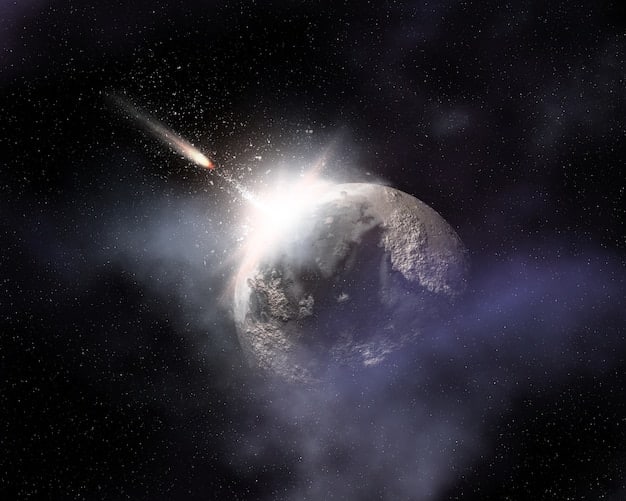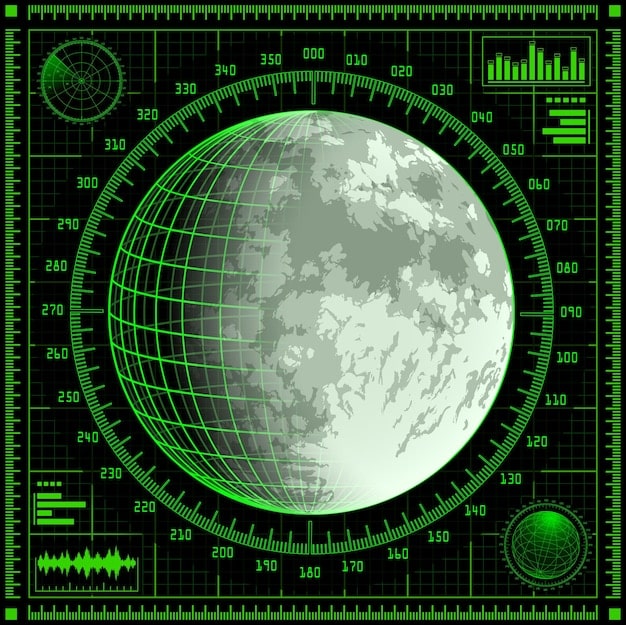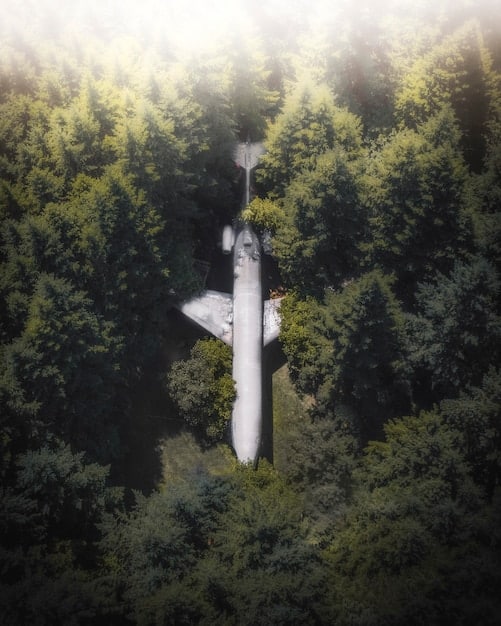NASA’s Planetary Defense: Tackling a New Asteroid Threat

NASA’s planetary defense strategy is crucial for mitigating potential asteroid impacts, utilizing a multi-faceted approach of detection, tracking, and mitigation technologies, with continuous research and international collaboration to safeguard Earth.
In an era of unprecedented astronomical discovery, the universe continues to present both wonders and challenges. One such challenge recently emerged: Alert: A newly discovered asteroid poses a potential threat to Earth – what is NASA’s plan for planetary defense? This revelation immediately raises critical questions about our planet’s vulnerability and the sophisticated measures in place to protect it.
Understanding the Asteroid Threat
The universe is filled with countless celestial bodies, and among them are asteroids – rocky remnants left over from the early formation of our solar system. While most orbit peacefully within the asteroid belt between Mars and Jupiter, some have orbits that bring them dangerously close to Earth. These Near-Earth Objects (NEOs) are of particular interest to scientists and planetary defense strategists because of their potential to cause significant widespread damage upon impact.
The recent detection of a new asteroid with a concerning trajectory highlights the dynamic nature of our cosmic neighborhood and the constant need for vigilance. Such discoveries, though often unsettling, underscore the remarkable progress in astronomical detection capabilities. Modern telescopes and sophisticated algorithms allow scientists to identify and track objects that were once invisible to us, providing crucial lead times for analysis and potential action.
Types of Asteroid Threats
Not all asteroids are created equal in terms of threat. Their size, composition, trajectory, and speed are all factors that influence the potential damage they could inflict. Understanding these distinctions is fundamental to formulating effective defense strategies.
- Potentially Hazardous Asteroids (PHAs): These are NEOs with orbits that come within 0.05 astronomical units (approximately 7.5 million kilometers or 4.6 million miles) of Earth and have an absolute magnitude of 22.0 or brighter (indicating a size of about 150 meters or larger). The recently discovered asteroid likely falls into this category.
- Impact Probability: Scientists calculate the probability of an asteroid hitting Earth based on its observed trajectory. Even a very low probability warrants attention if the asteroid is large enough to cause significant regional or global devastation.
- Kinetic Energy: The destructive power of an impact is directly related to an asteroid’s mass and speed. Larger, faster asteroids carry immense kinetic energy, capable of creating impact craters, tsunamis, and widespread atmospheric disruptions.
The constant monitoring of these celestial wanderers requires a global effort, leveraging ground-based observatories and space-based telescopes. This cooperative network ensures that potential threats are identified as early as possible, allowing for comprehensive risk assessments and enabling proactive responses.
Historical Context and Lessons Learned
Earth has a long history of asteroid impacts, lessons from which continue to inform our modern understanding of planetary defense. Events like the Tunguska explosion in 1908, a suspected air burst of a small asteroid or comet over Siberia, demonstrated the localized yet devastating power of even relatively small objects. More famously, the Chicxulub impact 66 million years ago, believed to have caused the extinction of the dinosaurs, serves as a stark reminder of the global catastrophe a truly large asteroid can unleash.
These historical events underline the importance of proactive measures. While impacts from large, civilization-ending asteroids are rare, the consequences would be catastrophic. Smaller impacts, while more frequent, can still cause significant regional damage and economic disruption. Therefore, a comprehensive planetary defense strategy must account for a wide range of potential impact scenarios, from localized events to global cataclysms.
The ongoing study of past impacts provides invaluable data for modeling future scenarios and validating mitigation techniques. It’s a continuous learning process, where every new discovery and every new piece of information refines our understanding and strengthens our defenses.
NASA’s Role in Planetary Defense
The detection of a newly identified asteroid that poses a potential threat immediately brings NASA’s planetary defense efforts into sharp focus. Far from being a theoretical exercise, planetary defense is a tangible and increasingly sophisticated mission for the space agency. NASA’s commitment to this critical undertaking is demonstrated through its dedicated programs and its active role in global scientific collaboration, embodying a proactive approach to safeguarding our home planet.
At the heart of NASA’s strategy is the Planetary Defense Coordination Office (PDCO), established in 2016. This office is specifically tasked with detecting and tracking Near-Earth Objects (NEOs), assessing their potential impact risk, and coordinating efforts to develop and implement mitigation strategies. The PDCO serves as a central hub, integrating data from various observatories and research initiatives worldwide, ensuring a cohesive and effective response to potential cosmic threats.
The Planetary Defense Coordination Office (PDCO)
The PDCO represents a formalized, comprehensive approach to asteroid defense. Its responsibilities extend beyond mere detection, encompassing a full spectrum of activities designed to protect Earth. This includes managing observation facilities, developing advanced tracking methodologies, and fostering international partnerships to share data and expertise. The establishment of PDCO underscores the seriousness with which NASA views the asteroid threat and its dedication to a multi-layered defense system.
- Detection and Tracking: The first line of defense involves systematic surveys to discover as many NEOs as possible. Programs like the Near-Earth Object Wide-field Infrared Survey Explorer (NEOWISE) and ground-based telescopes continuously scan the skies.
- Characterization: Once an asteroid is detected, scientists work to determine its size, shape, composition, rotation, and orbit. This detailed characterization is essential for predicting its trajectory and evaluating potential mitigation options.
- Risk Assessment: Based on trajectory predictions and characterization data, the PDCO assesses the probability of an impact and the potential consequences. This information is then communicated to government agencies and the public.
The PDCO also plays a crucial role in public outreach and education, ensuring that information about asteroid threats and defense strategies is accurately and transparently communicated. This helps to foster public understanding and reduce undue alarm, while still conveying the importance of the work being done.

International Collaboration and Data Sharing
Planetary defense is inherently a global endeavor. An asteroid impact knows no national borders, and therefore, the effort to prevent one demands international cooperation. NASA actively engages with space agencies and scientific organizations worldwide, sharing data, best practices, and research findings. This collaborative spirit is vital for maximizing our collective ability to detect, track, and ultimately mitigate asteroid threats.
Key international partners include the European Space Agency (ESA), the United Nations Office for Outer Space Affairs (UNOOSA), and various other national space agencies and astronomical observatories. These partnerships facilitate a coordinated global response, ensuring that observations are cross-referenced and data gaps are minimized. joint exercises and simulated impact scenarios are also conducted to refine emergency response protocols and improve decision-making processes.
The International Asteroid Warning Network (IAWN), supported by UNOOSA, is a prime example of this collaboration. IAWN is a global network of astronomical observatories and organizations that detect, track, and characterize NEOs. It provides a formalized structure for the international exchange of information and analysis concerning potentially hazardous asteroids, enabling a unified global response to emerging threats. This network is a testament to the idea that by working together, humanity stands a much stronger chance of protecting itself from cosmic dangers.
Detection and Tracking Technologies
The first and arguably most critical step in planetary defense is accurate detection and meticulous tracking of Near-Earth Objects (NEOs). The ability to identify these celestial wanderers early, and to predict their trajectories with precision, provides the necessary lead time for any potential mitigation efforts. NASA and its partners employ a sophisticated array of technologies, both ground-based and space-based, to maintain a vigilant watch over our cosmic neighborhood, acting as Earth’s early warning system.
The process begins with wide-field surveys, which repeatedly scan large portions of the night sky, looking for faint moving objects. Once a potential NEO is spotted, follow-up observations are conducted by more powerful telescopes to confirm its existence and begin defining its orbit. This iterative process of detection and refinement is crucial for building accurate orbital models and assessing potential risks.
Ground-Based Observatories
Ground-based telescopes are the workhorses of asteroid detection. Utilizing powerful mirrors and highly sensitive cameras, these observatories can detect faint objects over vast distances. Many are operated by universities, private organizations, or national observatories, but their data is often integrated into NASA’s planetary defense efforts. The cumulative efforts of these facilities provide a comprehensive sky survey.
- Catalina Sky Survey (CSS): Located in Arizona, USA, CSS is one of the most prolific NEO discovery programs, responsible for finding a significant percentage of all known NEOs. It uses multiple telescopes to survey the sky.
- Pan-STARRS: The Panoramic Survey Telescope and Rapid Response System, located in Hawaii, is another key player. Its wide-field cameras and rapid survey capabilities make it highly effective at detecting new objects and refining orbits of known ones.
- Arecibo Observatory (historical): Although its main dish famously collapsed, the Arecibo Observatory in Puerto Rico had been a pioneer in using radar astronomy to precisely characterize asteroid sizes, shapes, and rotational states, providing invaluable insights beyond optical observations.
The vast network of ground-based observatories provides continuous coverage, allowing for rapid follow-up observations when a new object is detected. This redundancy and widespread geographical distribution are key to overcoming limitations like weather conditions or daylight hours, ensuring that the sky is monitored around the clock.
Space-Based Telescopes
While ground-based observatories are highly effective, they are limited by Earth’s atmosphere, which can distort or absorb certain wavelengths of light, and by the planet itself, which blocks views of certain parts of the sky. Space-based telescopes overcome these limitations, offering a clear, unobstructed view of the cosmos and the ability to detect asteroids in infrared wavelengths, which can reveal objects too dim to be seen optically.
NASA’s Near-Earth Object Wide-field Infrared Survey Explorer (NEOWISE) mission, for example, repurposed a space telescope to specifically hunt for NEOs using its infrared capabilities. Infrared is particularly useful because asteroids, even dark ones, emit heat, making them easier to spot against the cold backdrop of space. NEOWISE has been instrumental in discovering and characterizing thousands of NEOs, providing vital data to the PDCO.
Future space-based missions, such as the NEO Surveyor, are being developed to further enhance our detection capabilities. NEO Surveyor will be optimized to find virtually all potentially hazardous asteroids 140 meters in size and larger, significantly improving our inventory of dangerous objects and providing even earlier warnings. These dedicated space assets are critical for complementing ground-based efforts and ensuring a comprehensive watch over our planet.
The combination of ground-based and space-based assets creates a robust and layered detection system. Ground telescopes provide real-time broad surveys and follow-up, while space telescopes offer an unobstructed view and unique infrared capabilities. This synergistic approach maximizes the chances of early detection and precise tracking, giving humanity the maximum possible time to respond to any inbound threat.
Mitigation Strategies: How to Deflect an Asteroid
Once a potentially hazardous asteroid is detected and its trajectory confirmed to pose a threat, the focus shifts from detection to mitigation. This is where the science fiction scenarios of asteroid deflection begin to intersect with cutting-edge scientific engineering. NASA, in collaboration with international partners, is actively researching and developing several viable strategies to alter an asteroid’s course, ensuring it safely passes by Earth instead of impacting it.
The key principle behind most deflection strategies is to impart a small, precise change in the asteroid’s velocity (delta-V) far enough in advance that this tiny nudge translates into a significant change in its trajectory by the time it reaches Earth’s orbit. Timing is everything; even a subtle deflection can prevent an impact if executed years or decades before the predicted close approach.
Kinetic Impactors
Perhaps the most straightforward and currently best-understood method for asteroid deflection is the kinetic impactor. This strategy involves sending a spacecraft to intentionally collide with the asteroid at high speed. The momentum transferred from the spacecraft to the asteroid would subtly alter the asteroid’s velocity, thereby changing its orbital path. The success of this method hinges on precise targeting and sufficient lead time.
- DART Mission (Double Asteroid Redirection Test): NASA’s DART mission, launched in November 2021, was the first full-scale demonstration of kinetic impactor technology. It successfully impacted Dimorphos, the moonlet of the asteroid Didymos, in September 2022.
- Result of DART: The DART mission successfully altered Dimorphos’s orbital period around Didymos by 32 minutes, far exceeding the initial expectation of 10 minutes. This groundbreaking success proved the viability of kinetic impactors as a planetary defense strategy.
- Follow-up Missions: The European Space Agency’s Hera mission will follow up on DART by studying Dimorphos’s altered orbit and crater, providing crucial data for refining kinetic impactor models.
The DART mission provided invaluable real-world data, transforming a theoretical concept into a proven capability. It confirmed that we can, in fact, exert sufficient force to change the trajectory of celestial bodies, offering a tangible solution for planetary defense. The knowledge gained from DART significantly advances our understanding of how to implement such a mission effectively in a real threat scenario.
Gravitational Tractor
Another promising long-term mitigation strategy is the gravitational tractor. This method involves positioning a massive spacecraft near the threatening asteroid. The spacecraft’s gravitational pull, though tiny, would exert a continuous, gentle tug on the asteroid over an extended period. This subtle but persistent force would slowly pull the asteroid off its collision course, much like a miniature tugboat steering a large ship.
The advantages of a gravitational tractor are its precision and its non-contact nature. Since there’s no physical impact, there’s no risk of breaking up the asteroid into smaller, potentially more hazardous fragments. However, this method requires a long lead time – often years or even decades – to achieve the necessary deflection, as the gravitational forces involved are extremely weak. It would be most suitable for large asteroids detected well in advance.
Research into gravitational tractor technology focuses on optimizing spacecraft mass, propulsion systems for long-duration station-keeping, and precise navigation to maintain the optimal proximity to the asteroid for the required duration. While DART proved kinetic impactors, gravitational tractors offer a complementary, gentler solution for specific threat scenarios, particularly those identified with ample warning.

Other Concepts and Future Research
Beyond kinetic impactors and gravitational tractors, scientists are exploring various other innovative concepts for asteroid deflection, though these are generally in earlier stages of development or are considered for very specific scenarios. These include nuclear options, ablative techniques, and even painting an asteroid.
- Nuclear Detonation: While controversial and a last resort, a nuclear device could be detonated near an asteroid (not on it) to vaporize part of its surface, creating a propulsive jet that pushes it off course. This method is primarily considered for very large asteroids with minimal warning time, where other methods would be ineffective.
- Ablation and Laser Beams: Focusing high-power lasers or solar concentrators onto an asteroid’s surface could vaporize material, creating a tiny jet that slowly nudges the asteroid. This “laser ablation” technique is theoretically precise but requires significant power and a long period of operation.
- Asteroid Painting: Changing an asteroid’s albedo (reflectivity) by painting it could alter how much solar radiation it absorbs and re-emits. This subtle change in radiation pressure, known as the Yarkovsky effect, could slowly shift its orbit over very long periods. This method would only work for certain types of asteroids and would require decades of lead time.
NASA continues to invest in research and development across multiple mitigation strategies. The goal is to have a diverse toolkit of options, allowing for the most effective and appropriate response based on the specific characteristics of an incoming asteroid (size, composition, rotation, and how much warning time is available). The ongoing exploration of these cutting-edge techniques ensures that humanity is as prepared as possible for whatever the cosmos might throw its way.
The Latest Discovery and Its Implications
The recent announcement of a newly discovered asteroid posing a potential threat to Earth immediately activates the established planetary defense protocols. While such alerts can naturally cause concern, it’s crucial to understand the implications within the context of NASA’s robust and layered defense strategy. This discovery is a testament to the advancements in detection capabilities, rather than an indication of imminent doom.
When a new asteroid is identified with a trajectory that intersects Earth’s orbital path, it is initially flagged as a “potential threat.” This designation does not automatically mean an impact is guaranteed or even highly probable. Instead, it triggers a period of intensive observation and data analysis to refine the asteroid’s orbit and assess the true level of risk. This scientific due diligence is a cornerstone of responsible planetary defense.
Initial Assessment and Follow-Up Observations
Upon initial detection, astronomers gather as many observations as possible over a short period to establish a preliminary orbit for the newly found asteroid. Even with limited data, supercomputers can model millions of possible trajectories, identifying which ones might intersect Earth’s orbit. This initial assessment helps to classify the object as a Near-Earth Object (NEO) and, if relevant, a Potentially Hazardous Asteroid (PHA).
The next critical phase involves extensive follow-up observations. Using multiple telescopes, often from different locations around the globe, astronomers track the asteroid over days, weeks, and months. Each new data point refines the asteroid’s orbital path, narrowing down the potential impact corridor and significantly reducing the uncertainties in its trajectory. The more data collected, the more precise the prediction becomes.
During this period, the asteroid’s size, rotation, and general composition may also be estimated through photometric and spectroscopic analysis. This information is vital for understanding what kind of impactor it might be and which mitigation strategies would be most effective if deflection were ever deemed necessary.
Determining the True Threat Level
For most newly discovered “threats,” further observations quickly reveal that the asteroid is highly unlikely to impact Earth, often passing by at a considerable distance. The initial “potential threat” status is often a result of limited initial data, which inherently carries larger uncertainties in orbital predictions. As more data comes in, these uncertainties shrink, leading to a clearer picture of the asteroid’s true path.
NASA and its international partners use sophisticated software to calculate impact probabilities, often expressing these on scales like the Torino Scale or the Palermo Technical Impact Hazard Scale. These scales integrate the likelihood of an impact with the potential consequences (size of the asteroid) to provide a standardized measure of risk, facilitating clear communication to scientists and the public.
- Torino Scale: A simple 0-10 scale rating the impact risk of NEOs, with 0 meaning no hazard and 10 indicating certain global catastrophe. Most newly discovered asteroids typically initially register low on this scale, moving to zero as more data is collected.
- Palermo Technical Impact Hazard Scale: A more complex logarithmic scale used by professionals to quantify and compare the risk of specific potential impacts, taking into account the probability of impact and the kinetic energy of the object.
The ongoing monitoring of an asteroid that initially poses a potential threat is a standard procedure. In the vast majority of cases, these objects are statistically determined to be harmless, eventually removed from the “threat” list as their safe passage is confirmed. However, the system is designed to err on the side of caution, ensuring that no genuine threat goes undetected or unassessed. The process reflects a balanced approach: diligence without alarmism.
Future of Planetary Defense
The field of planetary defense is dynamic and continuously evolving, driven by technological innovation, expanding astronomical knowledge, and the imperative to protect our planet. The recent alert about a newly discovered asteroid, while a testament to current capabilities, also serves as a poignant reminder that much work remains to be done. The future of planetary defense hinges on several key pillars: advancing detection, refining mitigation, and fostering global readiness.
Looking ahead, NASA and its international collaborators are not only focused on improving existing methods but also on developing entirely new approaches. The goal is to build an even more resilient and comprehensive defense system, capable of addressing a wider range of potential asteroid threats with greater speed and precision. This involves significant investments in research and development, as well as strengthening international frameworks.
Advancements in Detection and Tracking
A primary focus for the future is to enhance our ability to detect smaller, fainter asteroids, particularly those that originate from areas difficult to observe from Earth, such as objects coming from the direction of the Sun. Upcoming missions and technologies aim to fill these observational gaps and provide even earlier warnings.
- NEO Surveyor: This dedicated space-based infrared telescope, slated for launch in the mid-2020s, is designed to find most of the remaining undiscovered larger NEOs (140 meters and above). Its all-sky survey capabilities will significantly complete our inventory of potentially hazardous objects.
- Advanced Ground Observatories: Continued investment in new and upgraded ground-based telescopes, incorporating AI-driven analysis and automated search capabilities, will enhance their efficiency and sensitivity.
- Distributed Sensor Networks: Exploring the concept of a network of smaller, specialized telescopes, perhaps even in deep space, to provide continuous, all-sky coverage, minimizing observational gaps.
The integration of artificial intelligence and machine learning algorithms into detection systems will be crucial. These technologies can rapidly process vast amounts of astronomical data, identify subtle patterns indicative of new objects, and predict trajectories with increased accuracy. This will allow human scientists to focus on the most promising candidates for follow-up, streamlining the entire detection process.
Mitigation Refinement and Readiness
Building on the success of the DART mission, future efforts will focus on refining kinetic impactor technology and exploring other deflection concepts. This includes developing more capable spacecraft, improving targeting precision, and understanding the complex physics of asteroid impacts and their long-term effects on orbital mechanics. The key is to make these techniques reliable, scalable, and adaptable to various asteroid characteristics.
Furthermore, research into the “gravitational tractor” method will continue to mature, potentially leading to demonstrator missions. While slower, this method offers a precise, non-contact way of deflecting asteroids over long periods, making it ideal for threats identified decades in advance. The development of a diverse set of mitigation options ensures that humanity has multiple tools at its disposal, suitable for different threat scenarios.
Beyond technology, readiness also involves establishing clear decision-making protocols for when a real threat emerges. This includes international agreements on who makes the ultimate decision to attempt a deflection, how resources are allocated, and how the public is informed. Drills and simulated scenarios play a vital role in exercising these protocols and building international consensus on response mechanisms.
Global Collaboration and Public Engagement
Planetary defense is a responsibility that transcends national borders. Future success will depend heavily on sustained and deepened international collaboration. This involves sharing scientific data, technological advancements, and operational expertise. Organizations like the United Nations Office for Outer Space Affairs (UNOOSA) will continue to play a critical role in fostering these global partnerships and establishing universally accepted guidelines for planetary defense activities.
Effective public engagement is equally important. Educating the public about the true nature of asteroid threats, the science behind planetary defense, and the ongoing efforts to protect Earth helps to build trust and mitigate unnecessary panic when alerts are issued. Transparent communication, grounded in scientific accuracy, ensures that the public understands the risks and the substantial measures in place to address them.
The long-term vision for planetary defense is not merely to react to threats but to create a robust, preventative shield for our planet. This proactive stance, fueled by continuous innovation, international cooperation, and public understanding, will be essential in safeguarding Earth for generations to come. The goal is to move from merely hoping for the best to actively ensuring our safety from cosmic impacts.
Preparedness and Peace of Mind
The news that a newly discovered asteroid poses a potential threat to Earth naturally evokes a degree of apprehension. However, it is essential to contextualize this information within the broader framework of NASA’s highly organized and continuously evolving planetary defense strategy. The very fact that such an asteroid was discovered, tracked, and its potential threat announced is a testament to the significant advancements in our ability to monitor the cosmos and protect our planet.
Our growing understanding of Near-Earth Objects (NEOs) and the proactive measures being developed represent a collective step forward for humanity. We are no longer passive observers of cosmic events; instead, we are developing the means to understand, predict, and potentially alter them. This shift from vulnerability to agency provides a much-needed sense of security and peace of mind.
Ongoing Vigilance and Adaptive Strategy
Planetary defense is not a static endeavor; it is an ongoing mission that demands constant vigilance and an adaptive strategy. The universe is a dynamic place, and new objects will continue to be discovered, some of which may indeed warrant closer scrutiny. NASA and its partners are committed to maintaining this perpetual watch, continuously refining their detection capabilities and improving their orbital prediction models.
The strategy is adaptive because the characteristics of potential asteroid threats can vary widely, from small, fast-moving objects to slower, more massive ones. Each scenario may require a different approach for mitigation. This means that research into diverse deflection technologies will continue, ensuring a comprehensive toolkit is available for future challenges. The lessons learned from missions like DART are invaluable, providing real-world data to refine and validate these techniques.
Furthermore, the infrastructure for rapid information sharing and coordinated response is constantly being strengthened. This includes improving communication channels among international space agencies, refining decision-making frameworks, and conducting regular drills to ensure readiness in the face of a genuine threat. This multi-layered approach ensures that humanity is as prepared as possible for any eventuality.
The Importance of Investment and Public Awareness
The success of planetary defense hinges on sustained investment in scientific research, technological development, and international collaboration. These efforts require significant resources, which are justified by the profound importance of safeguarding our planet. Continued funding ensures that the best minds and most advanced technologies are dedicated to this critical mission, pushing the boundaries of what is possible in space exploration and protection.
Equally important is fostering public awareness and understanding. A well-informed public is better equipped to process information about potential asteroid threats without resorting to panic. Transparent communication from scientific bodies like NASA is crucial in explaining the science, the risks, and the defensive measures in place. This helps to build trust and support for ongoing planetary defense initiatives, encouraging long-term commitment to these vital programs.
Ultimately, the “alert” of a newly discovered asteroid should be viewed not as a source of fear, but as a demonstration of remarkable human ingenuity and foresight. It underscores our ability to confront cosmic challenges with scientific rigor, technological prowess, and global cooperation. The dedication of scientists and engineers across the globe provides us with a profound sense of peace of mind, knowing that a robust and effective plan is in place to protect Earth from potential celestial impacts.
| Key Point | Brief Description |
|---|---|
| 🔭 Asteroid Detection | NASA utilizes ground and space-based telescopes to discover and track Near-Earth Objects (NEOs). |
| 🛡️ Planetary Defense Office | The PDCO coordinates global efforts for risk assessment and potential mitigation strategies. |
| 🚀 Deflection Methods | Kinetic impactors (DART success) and gravitational tractors are leading mitigation techniques. |
| 🌐 Global Cooperation | International partnerships are crucial for shared data and a unified response to asteroid threats. |
Frequently Asked Questions About Asteroid Defense
▼
A Near-Earth Object (NEO) is an asteroid or comet whose orbit brings it into proximity with Earth’s orbit. These celestial bodies are constantly monitored by astronomers to assess any potential collision risk with our planet, forming the basis of planetary defense efforts by agencies like NASA.
▼
NASA detects new asteroids through a network of ground-based observatories and space-based telescopes. These instruments continuously scan the sky, looking for moving objects. Once detected, follow-up observations are conducted to refine the asteroid’s orbit and determine its potential threat level.
▼
A kinetic impactor is a method of asteroid deflection where a spacecraft intentionally crashes into an asteroid at high speed to alter its trajectory. Yes, NASA successfully tested this with the Double Asteroid Redirection Test (DART) mission in 2022, proving its viability.
▼
The warning time varies greatly depending on the asteroid’s size, speed, and trajectory. For larger, easier-to-detect asteroids, we might have years or even decades of warning. Smaller asteroids, especially those arriving from the Sun’s direction, could offer only days, or even hours, of notice.
▼
Typically, when an asteroid is initially reported as a “potential threat,” it means its preliminary orbit shows a possible close approach. Further observations are crucial to refine its trajectory. In most cases, these objects are determined to be non-threatening, safely passing by Earth without incident.
Conclusion
The discovery of a new asteroid posing a potential threat to Earth, while naturally concerning, serves as a powerful affirmation of the robust and evolving capabilities of NASA’s planetary defense system. Far from being a cause for alarm, this alert underscores a sophisticated global effort rooted in vigilant detection, precise tracking, and pioneering mitigation research. From the dedicated work of the Planetary Defense Coordination Office to the groundbreaking success of the DART mission, humanity is actively building a proactive shield against cosmic impacts. The commitment to continuous innovation, coupled with vital international collaboration, ensures that our planet is increasingly prepared to face whatever challenges the cosmos might present, providing a profound sense of security for future generations.





